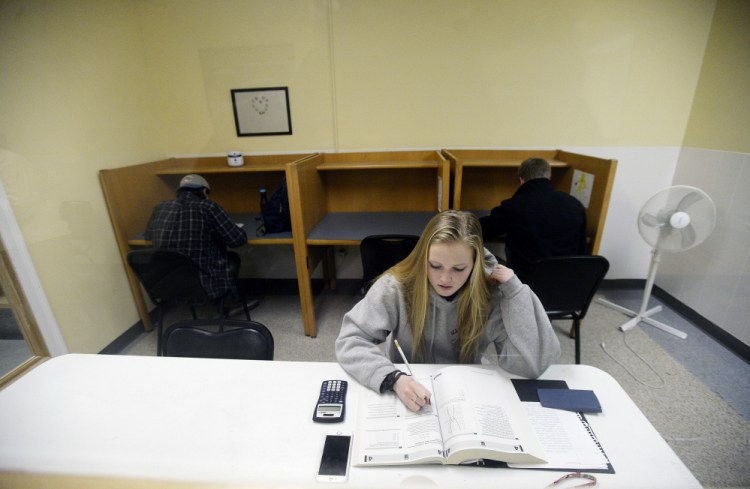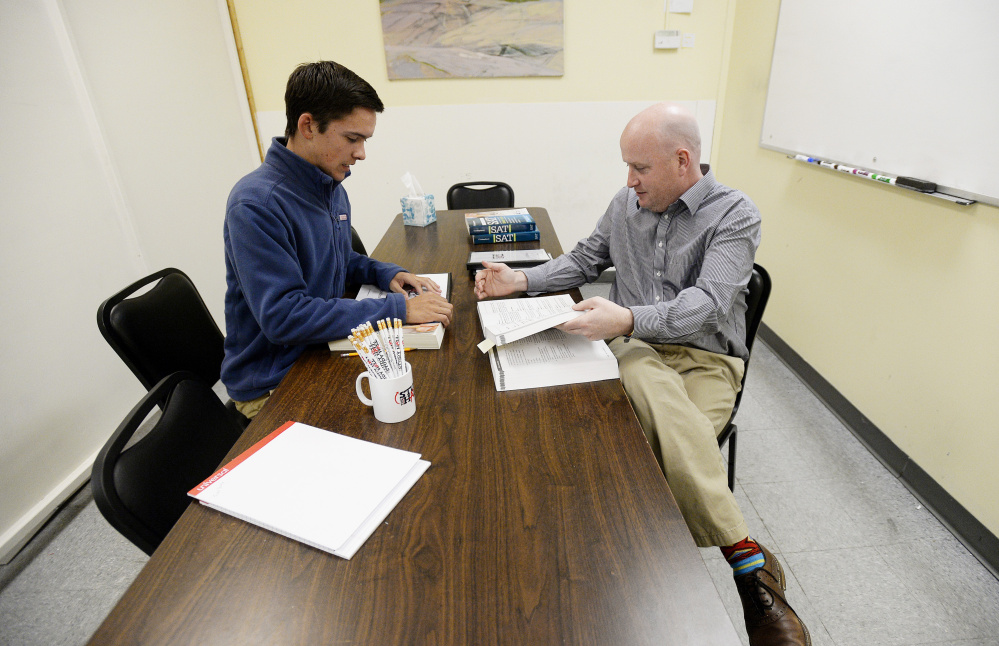After its first major overhaul in a decade, a new SAT exam will launch next Thursday with fewer sections, no more vocabulary lists, an optional essay, and a much bigger emphasis on critical thinking and reasoning.

“There’s lots of anxiety” surrounding the new test, said test prep tutor Paul Johnson, a co-owner of The Study Hall, which has three tutoring clinics in the Portland area. “Before it was a strategy test. (Now) it really rewards good students.”
Case in point: Johnson used to advise students not to guess, since they were penalized for incorrect answers. Now, they aren’t. Students learning more rigorous Common Core-aligned curriculum in the classroom, which emphasizes deeper comprehension, as does the new SAT, will do better in both English and math sections, he said.
But the new test could be more difficult for struggling students or weak readers, because it requires greater reading comprehension than the old version.
The intent of the changes, SAT officials say, is to have a more real-world test that reflects what students are learning and what colleges want to see in “college-ready” students.
“This is a new beginning for the SAT. Gone are obscure vocabulary words and tricky logic questions that are disconnected from the work students do every day,” said Stacy Caldwell, vice president of the SAT Program at the College Board, a nonprofit organization that owns the SAT. “Moving forward, students will encounter a test that focuses on the few things that matter most for college, work and life.”
The test was last revised in 2005.
The SAT and the ACT, another national standardized test, long have been staples for college admissions. And while colleges generally accept scores for either test, the ACT had a reputation for being skewed more toward math and science, while the SAT emphasized general thinking and problem-solving.
NEW TEST ‘LEVELS THE PLAYING FIELD’
Like any standardized test, the SAT has its critics, with many saying it favors students who are native English speakers and those who are well-off and can afford test prep classes. College Board officials said some of the recent changes are aimed at leveling the playing field.
As part of the new SAT rollout, the College Board partnered with online education company Khan Academy to offer free personalized prep materials. The site, satpractice.org, has practice tests, short quizzes and personalized recommendations based on a student’s strengths and weaknesses. The College Board also has an app, called Daily Practice for the SAT, that allows students to take a picture of an answer sheet and get instant scores.
“It absolutely levels the playing field. It’s a fundamental game-changer,” said Mary Ellen Auriemma, a senior director for the College Board in the New England region.
In Maine, the SAT has historically been required as the 11th grade statewide standardized test, leading to high participation rates. Last year, 13,936 students, or 96 percent of high school juniors, took the SAT.
Scarborough High School junior Rachel Barr said she studied and prepped for the old SAT, and now she’s doing it again for the new one. Like many students, she is taking the test multiple times to try to improve her score.
She did all right the first time, but is hoping the changes will work in her favor.
“I’ve never been a fan of geometry, so I’m glad there’s less,” said Barr, who was at The Study Hall in Scarborough.
Her twin, Ryan Barr, also likes that the math section will have more algebra and less geometry.
“You can check your answers with algebra,” he said. “And they got rid of the vocabulary, which is good.”
FEWER QUESTIONS, OPTIONAL ESSAY
Other changes include eliminating sentence completions and analogies. Multiple-choice questions have four possible answers instead of five. There are fewer questions, 154 versus 171. The timing is similar, with 3 hours, 45 minutes on the old SAT versus 3 hours, with an additional 50 minutes for the optional essay, on the new SAT.
College Board officials note that some things haven’t changed: The new and old SATs have roughly the same number of words, so there isn’t “more” reading material, and while the math problems require deeper comprehension skills, there is the same percentage of word problems.
The vocabulary changes have grabbed a lot of the attention. Even the College Board poked fun at itself when it unveiled the new SAT:
“Throughout its 100-year history, the abstruse vocabulary words of the SAT have engendered prodigious vexation in millions of examinees annually,” it said in a statement. “To adumbrate the changes to be manifest in future administrations of the assessment: The new SAT will be more trenchant and pellucid, and the format will no longer pertinaciously reward students who punctiliously engage in the antediluvian praxis of committing idiosyncratic words to memory.”
College Board President David Coleman promulgated, “Your invectives and maledictions have been heard. Clemency has been granted.”
In other words: Chill. It’s going to be a lot easier to at least read the new SAT.
‘WHAT STUDENTS ARE LEARNING’
But College Board officials emphasize that the trade-off is a sharper emphasis on depth of knowledge.
Obscure words are gone, but students must be able to understand and explain the meaning of words in different contexts and how word choice shapes meaning, tone and impact.
For example, in a practice test, the new SAT highlighted certain words in a passage from Charlotte Bronte’s “The Professor” and asks what those words are meant to convey. (“The references to “shade” and “darkness” at the end of the first paragraph mainly have which effect? A) They evoke the narrator’s sense of dismay. B) They reflect the narrator’s sinister thoughts. C) They capture the narrator’s fear of confinement. D) They reveal the narrator’s longing for rest.)
Math problems are different as well, Johnson said. They involve more real-world situations, such as figuring out how to change a college survey to lower the margin of error, or calculating the cost of a hotel stay, and are sometimes couched in word problems, as opposed to straight mathematical equations.
(“At a lunch stand, each hamburger has 50 more calories than each order of fries. If 2 hamburgers and 3 orders of fries have a total of 1,700 calories, how many calories does a hamburger have?”)
“We want this to be an assessment of what students are learning in classrooms each and every day,” Auriemma said. “If you are a student who studies and pays attention in school and you practice, you will do well.”
Send questions/comments to the editors.





Success. Please wait for the page to reload. If the page does not reload within 5 seconds, please refresh the page.
Enter your email and password to access comments.
Hi, to comment on stories you must . This profile is in addition to your subscription and website login.
Already have a commenting profile? .
Invalid username/password.
Please check your email to confirm and complete your registration.
Only subscribers are eligible to post comments. Please subscribe or login first for digital access. Here’s why.
Use the form below to reset your password. When you've submitted your account email, we will send an email with a reset code.